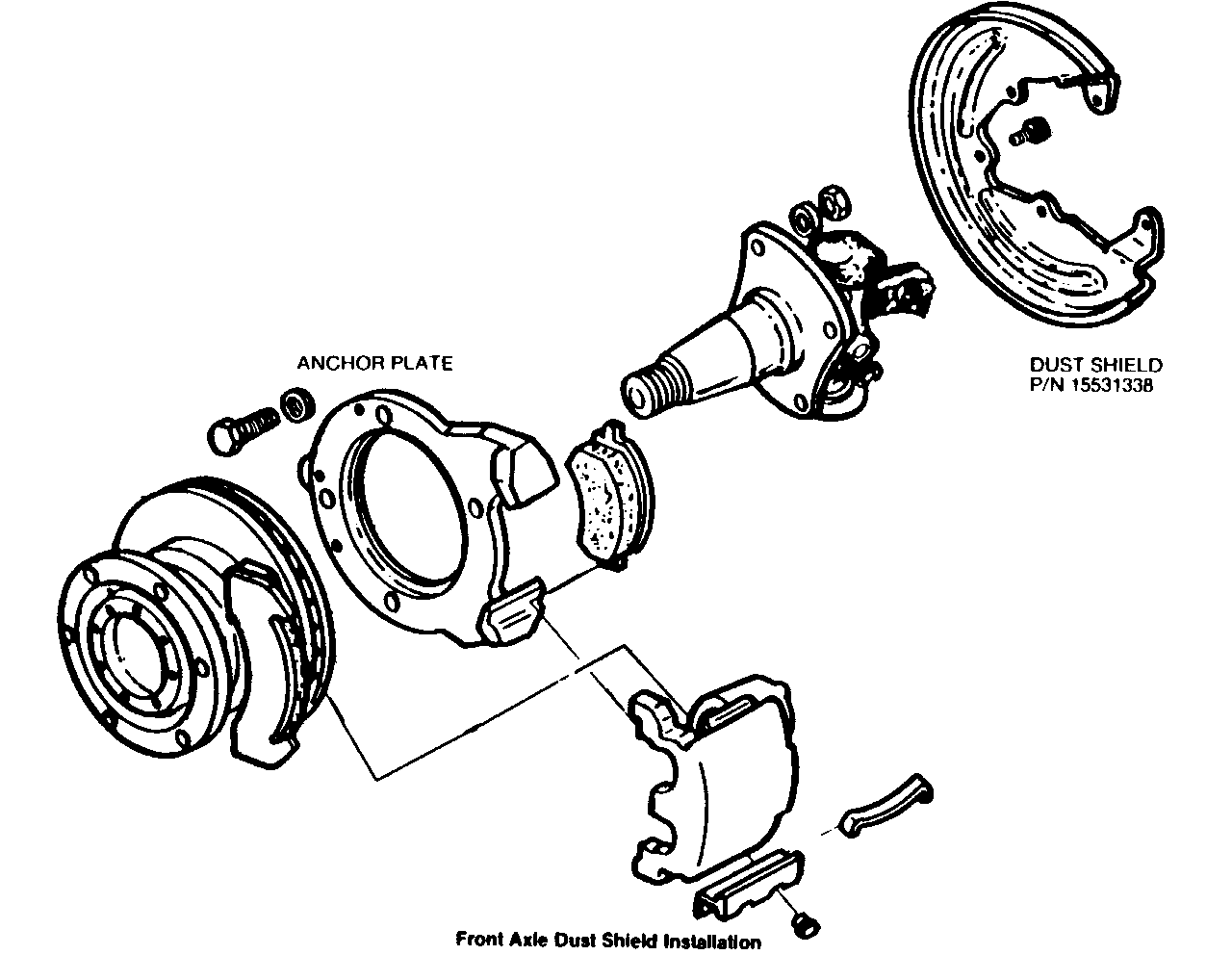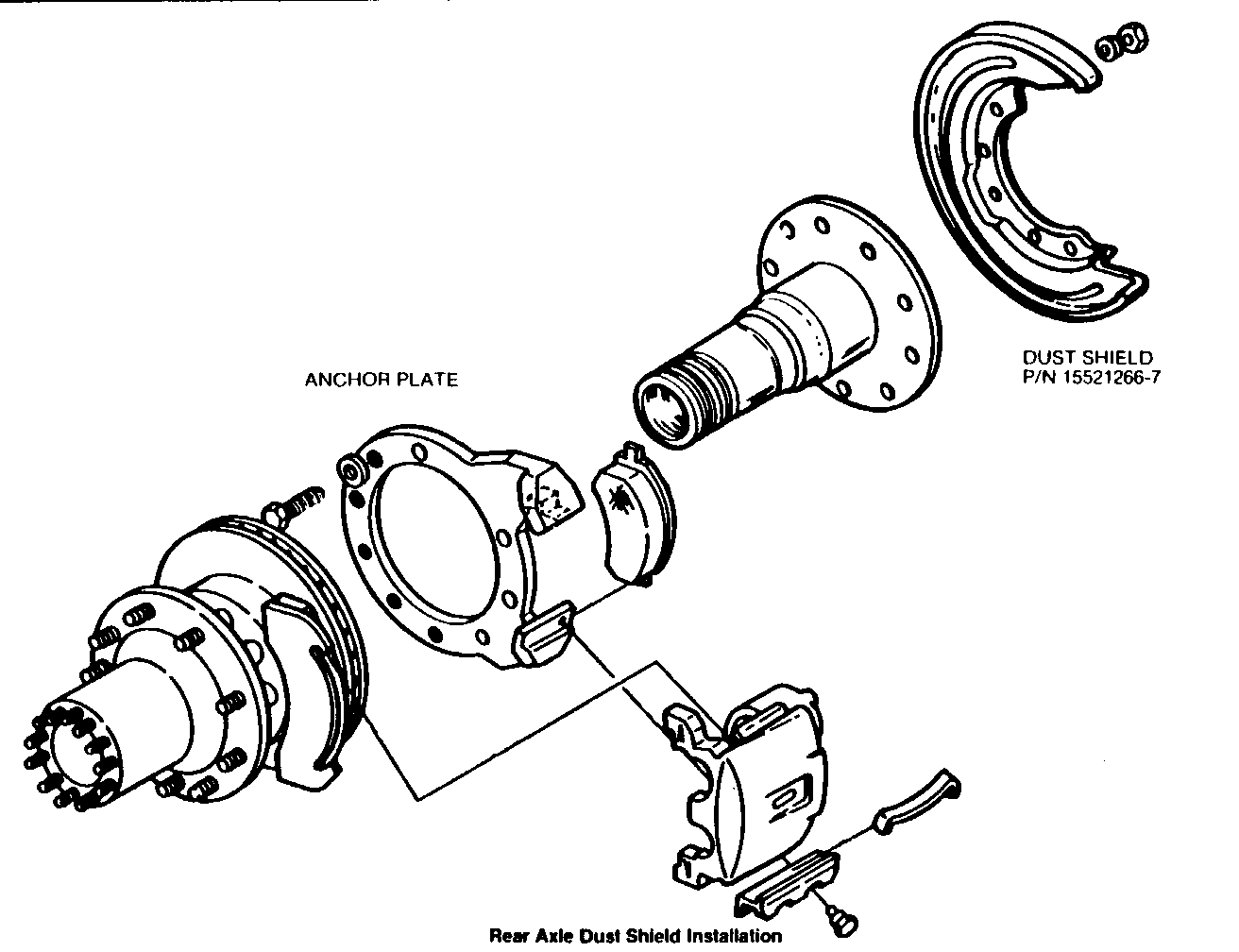DISC BRAKE WEAR/NOISE INSTALL NEW LININGS & DUST SHIELDS

Subject: DISC BRAKES WEAR/NOISE
Model and Year: 1983-85 MEDIUM DUTY WITH HYDRAULIC DISC BRAKES. FRONT BRAKES INCLUDED ONLY ON VEHICLES WITH RPO F43/F54 9,000 LB OR 12,000 LB FRONT AXLE
Some 1983 - 1985 Medium Duty vehicles equipped with hydraulic disc brakes may experience premature brake lining and rotor wear and/or excessive brake noise. Effective with January, 1985, production, VIN 1GDG4T1T9FV506723, new brake linings and dust shields are being installed on subject vehicles for repair of the wear and noise conditions. The new brake linings are formu- lated from a different material composition than that used on vehicles built prior to the VIN breakpoint. This new material will offer increased lining and rotor life and reduced brake noise. Additionally, the leading and trail- ing edges of the outer linings are chamfered for noise reduction purposes. Refer to the parts information section for lining kit part number.
Front and rear brake dust shields are being installed on these units to protect the brakes from road dirt, thus increasing lining and rotor life. The following service procedures are to be used for retrofit of front and rear dust shields.
SERVICE PROCEDURE
NOTICE: ALWAYS MAKE SURE THAT THE BRAKES ARE OPERATIONAL AFTER PERFORMING BRAKE WORK AND BEFORE RETURNING THE VEHICLE TO SERVICE.
FRONT DUST SHIELD INSTALLATION
Block the vehicle rear wheels and raise and support the front axle.
Remove tire.
Remove caliper.
Remove hubcap, wheel bearing assembly, and hub/wheel and disc/rotor assembly from the front axle.
Remove anchor plate.
Mark the three holes of the dust shield on the anchor plate. The shield can be used as a template (See Figure No. 1).
Center punch the three holes.
Drill and tap the three holes for an M8 x 1.25 bolt.
Mount the dust shield on the back side of the anchor plate using the bolts and washers listed in the parts information section. Torque to 15-23 N.m. The dust shield should fit around the anchor plate (See Figure No. 2).
Reinstall anchor plate on the spindle and torque the bolts to 540-610 N.m.
Reinstall hub/wheel and disc/rotor assembly on the axle.
Reinstall wheel bearing assembly, hubcap and caliper.
Reinstall tire and repeat the procedure on the opposite side.
Bleed Brakes.
Lower vehicle.
This repair, both sides, can be accomplished in approximately 2.7 hours.
REAR DUST SHIELD INSTALLATION
Block the vehicle front wheels and raise and support the rear axle.
Remove tires.
Remove axle shaft.
Remove caliper.
Remove wheel bearing and hub/wheel and disc/rotor assembly.
Remove the five bolts of the anchor plate as highlighted in Figure No. 3 and install the dust shield on the back side of the anchor plate. The dust shield should fit around the anchor plate. Torque the bolts to 175-190 N.m.
Reinstall hub/wheel and disc/rotor assembly.
Reinstall axle shaft.
Reinstall caliper.
Reinstall tire and repeat the procedure on the opposite side.
Bleed brakes.
Lower vehicle.
This repair, both sides, can be accomplished in approximately 2.5 hours. Add .7 hours if vehicle is equipped with 10-stud Budd wheels.
PARTS INFORMATION
Part Number Description Quantity Per Axle ----------- ------------------------- --------------- 15532027 Lining Kit - Front & Rear 1 15521266 Shield - Rear LH 1 15521267 Shield - Rear RH 1 15531338 Shield - Front 2 11500915 Bolt 6 2436162 Washer 6
These parts can be procured through the WDDGM ordering system.



General Motors bulletins are intended for use by professional technicians, not a "do-it-yourselfer". They are written to inform those technicians of conditions that may occur on some vehicles, or to provide information that could assist in the proper service of a vehicle. Properly trained technicians have the equipment, tools, safety instructions and know-how to do a job properly and safely. If a condition is described, do not assume that the bulletin applies to your vehicle, or that your vehicle will have that condition. See a General Motors dealer servicing your brand of General Motors vehicle for information on whether your vehicle may benefit from the information.
